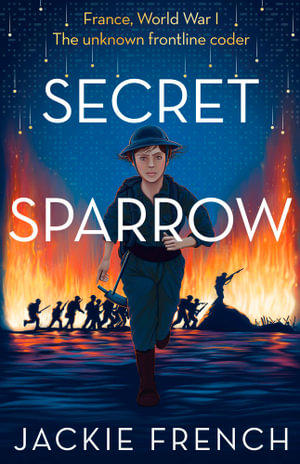Secret sparrow by Jackie French

Jackie French AM, an acclaimed Australian author, was Australian Children' Laureate in 2014-15. As a teacher and Librarian, this writer has tended to recommend Jackie French for primary and middle school classroom teachers when they are selecting novels to enhance the teaching of history. French's historical fiction brings to life the periods of time that students learn about as they can immerse themselves, through the eyes of the protagonists, into different historical periods. Likewise when students come looking for a good read, this writer has tended to point out the Jackie French section in the library, as anything by French (who writes prolifically and across the genres) is bound to be good!
Secret sparrow is a thought-provoking book based on the undocumented work of young girls and women in WW1 as signallers in France. Such was the shame of the British army about its use of young women during WW1, that they destroyed all documents pertaining to such. As French is an historian, she unearthed references in poems, letters and information from an Irish historian with access to the archives of the Irish Postal Workers Union which had ignored the order to destroy all reference to the WW1 work of these women. Hence Secret sparrow is based on the truth and dedicated to "all the Jean McLains."
Positioning herself as third person narrator, French tells the story of Jean McLain's life with each chapter entitled with its own location and time setting. The story begins in 1978 in rural Burrangong, NSW, with a young boy called Arjun racing to outrun a flood. Jean McLain, our WW1 signaller, now an old lady, rescues Arjun and they endure a life-threatening night submerged in rising, freezing cold floodwaters. In order to sustain the will to survive, Jean tells her story - an excellent authorial contrivance. The following chapter flashes back to Jean's early life as a 16-year-old post-office assistant living in idyllic, rural Butterwood, England in 1917 and her recruitment as a signaller in France as a "21 year-old" to replace male signallers who had been killed. The narrative flashes back and forth from the night of survival in 1978 Burrangong to the trenches of 1917 Rouen and Cambrai and elsewhere/somewhere in France.
The bravery and loyalty of Jean and the soldiers in the trenches is depicted along with the horror of WW1 trench warfare. Woven into this story of adventure and heroism is a love story.
The gradual excavation of the crucial role that women signallers played on the front line in army signal units on the Western Front has been further developed by French in Secret sparrow. French describes in an author's note at the end of the book, the difficulty of finding any information about their work. Being described as "postal workers" the army did not have to give any compensation to these women for permanent incapacitations as a result of their war work. The fact that women did this dangerous work on the front was never made public and they received no commendations or pensions.
Secret Sparrow opens up to the reader the fact of female work on the Western front in WW1 and the crucial role of army communication in war time - both aspects which, as a focus of war documentaries and literature, have been overlooked. The unknown Frontline coder (a sub title) indicates the raison d'etre for Secret Sparrow.
An interesting and accessible read, Secret Sparrow opens up another previously unstudied perspective on WW1.
Themes: WW1, Signallers in France, Women's war work, Loyalty.
Wendy Jeffrey